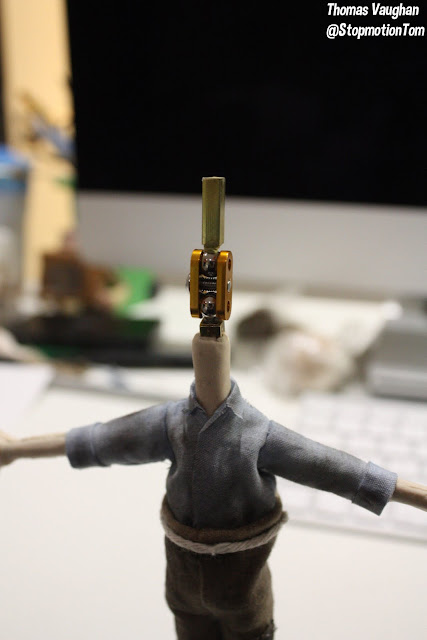I will admit, I was very bad at documenting the clothing process for Max!
During this time I went back home to the Rhondda (South Wales) to sew the clothes for Max as I needed my mothers help!! (I'm not good at sewing!)
During this time I forgot my camera and had to take photos on my phone, with this change, I kept forgetting to take photos as I was on such a tight deadline to finish the clothes within a couple of days.
But I do have some of when I was at home so hopefully you'll understand what i'm doing!
So here we go.
I needed to pad the armature out to begin. This was to ensure when the clothing was put on top it give the illusion that there is a body underneath.
The padding out was done in foam and then cut to size with a small scissors.
Once the foam was cut to shape the limbs, I then began the process of making the clothes.
To start the clothes, I began by wrapping cling film around the body.
Once cling film was wrapped around I could start wrapping the puppet in masking tape.

I would then cut the masking tape off with a scissor and I then had a template of the size of the leg. The cling film is added to easily remove the masking tape from the armature.

This is the part I forgot to take photos as I had a lot to do in very very little time to ensure I kept on schedule.
So the trousers were now done. To get the right fit, the trousers were sew and if they were to baggy and loose on the puppet, they were removed and re stitched closer together.

Now back in student accommodation, I now had to tidy up the clothing. To do the shirt, material was cut to a 'waistcoat' style on the armature, then sleeves were sewn on after. Again sorry for no pictures!
I was now at this stage and needed to cut the sleeves to where I wanted them.
Once cut the same was done on the other side.
To bring some character to the clothing I wanted Max to have a rope belt. therefore string was cut to length and then super glued on.
the string was not tied around the trousers. A piece of string was placed and glued around the trousers and a knot was glued to the front afterwards to give the illusion it was tied.
The more you know!
To ensure the edges of the fabric did not fray later on and while animating, I applied 'fray check' to the edges of the fabric, this is easy to apply and dries clear and hard to give a protective layer to the edges.
The collar was added on separately, to do this a pattern of a collar was cut to size.
The pattern was then folded to create the collar look and then secured on with a tiny dots of super glue.
The clothing was now done!!
The trousers were cut to short deliberetly to give more character to the clothing
Now it was time to add wear and tear to the clothing.
To make the clothing look dirty, old and worn chalk pastels were used, similar to how I did the head.
I mixed some black and brown chalk pastel shavings together
You can see the difference the chalk pastel make on the puppets left leg compared to his right.

Patches were also added to give a more old worn look. To do this I cut some small squares out of excess material I had. I began to fray the edges of this patch and then I applied fray check to ensure it kept the fray look, but stop any more fraying occurring. Then chalk pastel were brushed on to darken them up and then super glues to the fabric.
You'll have to look quite closely on the second image to actually see but I cut in to the back of the fabric to expose the K+S hole which would be used for the rig.
To cover this up to make the puppet look more aesthetically pleasing. I applied a patch of fabric to the back which looks like a pocket.
Only half of the pocket is glued on therefore I can expose and covered the K+S hole when needed.


When talking to my lecture he advised to have a ball joint for the neck.This was due to the stress the wire would go through with such a big head. Also if I wanted the head to turn side to side that would mean the wire within the neck would keep unraveling or tightening depending on the direction of the head turn. As I didnt have time to cast a new neck, and having a the ball joint within the neck would be to big of a neck for Max, we decided to attach the ball joint to the wire. This would bean the wire would be used to bend the head back and fourth, but the ball joint would be used for twisting of the head.
Complicated I know!
To finish the detail I decided to add buttons to the shirt. My first plan was to order very small ones of e-bay, however I could not find small enough button to be in scale with Max so I decided to sculpt them.
I rolled very small balls of super sculpey and then flattened them, I then out 2 holes in them with a needle and baked the button!
heres the size comparison to a grain of rice!
Clothing is not my favourite thing to do in the process of creating the character although they do make the characters personality! I may consider sculpting the clothing next year and casting them in silicone. But not to sure yet!





























































